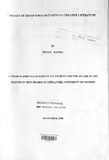| dc.description.abstract | In the intricate relationship between history and fiction, it is often assumed that a body of
fiction represents the values of a particular epoch. This sometimes ignores the inherent complexities
when such literature attempts to portray the specifics with reference to historical characters or events. The fictive and factual vie for supremacy as the artist tries to balance the demands of art,
history and purpose, providing unique challenges in art's creative reflection of history. The fiction
on the emergency period in the 1950's in Kenya is a case in point, more so the works on Dedan
Kimathi. Kenyan historians do not agree on the significance of Mau Mau. Interpretations are highly
subjective in favour of conflicting perspectives on Kimathi's role in the Mau Mau struggle.
The conflicting images of Kimathi in fictional works published texts provide the
justification of the present thesis. Three major texts - two plays and a novel, some songs and poetic compositions - portray Kimathi and the Mau Mau movement in different and conflicting images.
The study examines the nature of these images and linkages in the various interpretations of
Kimathi and the movement.
The research methodology has two components, library centred and a limited fieldwork
component. The library component examines historical and literary critics' perspectives on Kimathi's
portrayal and their insights into the subject.
The limited fieldwork focuses on songs and some written poems and views from sources
acquainted with Kimathi and the freedom struggle to supplement the analysis of published fictional
works. In the process, a comparative perspective becomes inevitable between earlier and later
works. The generic commonalties or diversities are noted and given due recognition. The plays, the
historical novel and the poetic compositions are, respectively, examined in different chapters.
The study uses the sociological approach to literary criticism as the analytical theoretical
framework. 1]te analysis reveals conflicting images as ideological statements of the economic and
social forces contending for supremacy in colonial and post-colonial Kenya, with the artists as
mouthpieces for these forces.
In the artist's sensibilities towards both Kimathi and the movement, one sees either
unequivocal acceptance of cause or varying degrees of emotionalfmtellectual distance. Among the
artists, Watene puts the greatest possible distance between himself and the "misguided" Mau Mau
leader he perceives in Kimathi, while Ngugi and Micere applaud altruistic human and heroic virtue
in Kimathi. In an attempt to settle the contentiousness of these extremes Kahiga chooses as his
springboard the liberal acco'mmodation ideology which Maughan-Brown sums up as 'balance' 'freedom of speech' and 'the need to present all sides of the argument' (175). Kahiga extols
Kimathi's heroism but paradoxically distances himself from the excesses of Mau Mau thereby
validating the colonial and post-colonial order of things in Kenya.
In the final analysis, the study suggests that the debate about the images of Kimathi in the
fiction of history of Kenya's independence struggle remains a gold-mine for further intellectual excavation. | en |

